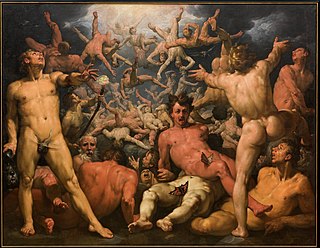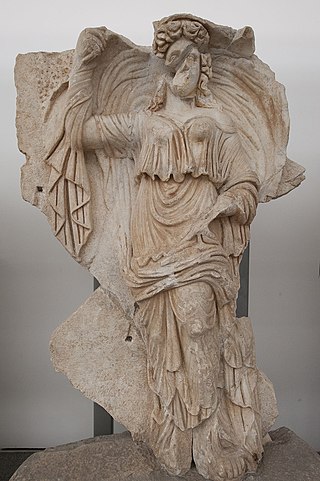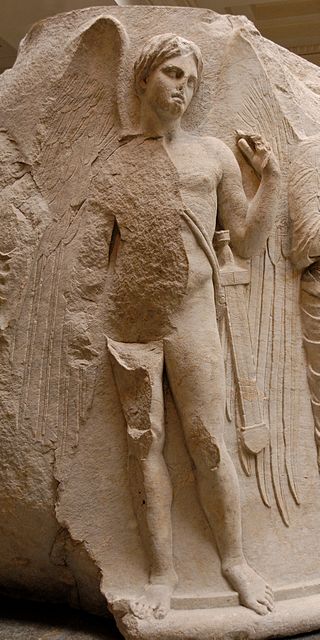Related Research Articles

In Greek mythology, Eris is the goddess and personification of strife and discord, particularly in war, and in the Iliad. According to Hesiod she was the daughter of primordial Nyx (Night), and the mother of a long list of undesirable personified abstractions, such as Ponos (Toil), Limos (Famine), Algae (Pains) and Ate (Delusion). Eris initiated a quarrel between Hera, Athena and Aphrodite, which led to the Judgement of Paris and ultimately the Trojan War. Eris's Roman equivalent is Discordia. According to Hesiod, there was another Eris, separate and distinct from Eris the daughter of Nyx, who was beneficial to men.

In Greek mythology, Hypnos, also spelled Hypnus, is the personification of sleep. The Roman equivalent is Somnus. His name is the origin of the word hypnosis. Pausanias wrote that Hypnos was the dearest friend of the Muses.

The Theogony is a poem by Hesiod describing the origins and genealogies of the Greek gods, composed c. 730–700 BC. It is written in the Epic dialect of Ancient Greek and contains 1022 lines. It is one of the most important sources for the understanding of early Greek cosmology.

In Greek mythology, the Titans were the pre-Olympian gods. According to the Theogony of Hesiod, they were the twelve children of the primordial parents Uranus (Sky) and Gaia (Earth), with six male Titans—Oceanus, Coeus, Crius, Hyperion, Iapetus, and Cronus—and six female Titans, called the Titanides or Titanesses—Theia, Rhea, Themis, Mnemosyne, Phoebe, and Tethys.

In Greek mythology and religion, Themis is the goddess and personification of justice, divine order, law, and custom. She is one of the twelve Titan children of Gaia and Uranus, and the second wife of Zeus. She is associated with oracles and prophecies, including the Oracle of Delphi. Her symbol is the Scales of Justice.

In ancient Greek religion and mythology, the Moirai —often known in English as the Fates—were the personifications of destiny. They were three sisters: Clotho, Lachesis, and Atropos. Their Roman equivalent is the Parcae.

Clotho or Klotho, is a mythological figure. She is the youngest goddess of the Three Fates or Moirai. In ancient Greek mythology, she spins the thread of human life, her sisters draw out (Lachesis) and cut (Atropos) the thread. Her Roman equivalent is Nona. She also made major decisions, such as when a person was born, thus in effect controlling people's lives. This power enabled her not only to choose who was born, but also to decide when deities or mortals were to be saved or put to death. For example, Clotho resurrected Pelops when his father killed him.

Atropos, in Greek mythology, was the third of the Three Fates or Moirai, goddesses of fate and destiny. Her Roman equivalent was Morta.
In Greek mythology, Erebus, or Erebos, is the personification of darkness. In Hesiod's Theogony, he is the offspring of Chaos, and the father of Aether and Hemera (Day) by Nyx (Night); in other Greek cosmogonies, he is the father of Aether, Eros, and Metis, or the first ruler of the gods. In genealogies given by Roman authors, he begets a large progeny of personifications upon Nox, while in an Orphic theogony, he is the offspring of Chronos (Time).

In Greek mythology, Hemera was the personification of day. According to Hesiod, she was the daughter of Erebus (Darkness) and Nyx (Night), and the sister of Aether. Though separate entities in Hesiod's Theogony, Hemera and Eos (Dawn) were often identified with each other.

In Greek mythology, Nyx is the goddess and personification of the night. In Hesiod's Theogony, she is the offspring of Chaos, and the mother of Aether and Hemera (Day) by Erebus (Darkness). By herself, she produces a brood of children which are mainly personifications of primarily negative forces. She features in a number of early cosmogonies, which place her as one of the first deities to exist. In the works of poets and playwrights, she lives at the ends of the Earth, and is often described as a black-robed goddess who drives through the sky in a chariot pulled by horses. In the Iliad, Homer relates that even Zeus fears to displease her.

In Greek mythology, dreams were sometimes personified as Oneiros or Oneiroi. In the Iliad of Homer, Zeus sends an Oneiros to appear to Agamemnon in a dream, while in Hesiod's Theogony, the Oneiroi are the sons of Nyx (Night), and brothers of Hypnos (Sleep).
In Greek mythology, Moros /ˈmɔːrɒs/ or Morus /ˈmɔːrəs/ is the personified spirit of impending doom, who drives mortals to their deadly fate. It was also said that Moros gave people the ability to foresee their death. His Roman equivalent was Fatum.

In Greek mythology, Thanatos was the personification of death. He was a minor figure in Greek mythology, often referred to but rarely appearing in person.

In Greek mythology, Geras, also written Gēras, was the god of old age. He was depicted as a tiny, shriveled old man. Gēras's opposite was Hebe, the goddess of youth. In Latin, he is referred to as Senectus. He is known primarily from vase depictions that show him with the hero Heracles; the mythic story that inspired these depictions has been lost.

Lachesis, in ancient Greek religion, was the middle of the Three Fates, or Moirai; the others were her sisters, Clotho and Atropos. Normally seen clothed in white, Lachesis is the measurer of the thread spun on Clotho's spindle, and in some texts, determines Destiny, or thread of life. Her Roman equivalent was Decima. Lachesis was the apportioner, deciding how much time for life was to be allowed for each person or being. She measured the thread of life with her rod. She is also said to have chosen a person's destiny after a thread was measured. In mythology, it is said that she appears with her sisters within three days of a baby's birth to decide the baby's fate.
In Greek mythology, the primordial deities are the first generation of gods and goddesses. These deities represented the fundamental forces and physical foundations of the world and were generally not actively worshipped, as they, for the most part, were not given human characteristics; they were instead personifications of places or abstract concepts.

The Potamoi are the gods of rivers and streams of the earth in Greek mythology.

The Fates are a common motif in European polytheism, most frequently represented as a trio of goddesses. The Fates shape the destiny of each human, often expressed in textile metaphors such as spinning fibers into yarn, or weaving threads on a loom. The trio are generally conceived of as sisters and are often given the names Clotho, Lachesis, and Atropos, which are the names of the Moirai, the version of the Fates who appear in Greek mythology. These divine figures are often artistically depicted as beautiful maidens with consideration to their serious responsibility: the life of mortals. Poets, on the other hand, typically express the Fates as ugly and unwavering, representing the gravity of their role within the mythological and human worlds.

The weighing of souls is a religious motif in which a person's life is assessed by weighing their soul immediately before or after death in order to judge their fate. This motif is most commonly seen in medieval Christianity.
References
- Gaius Julius Hyginus, Fabulae from The Myths of Hyginus translated and edited by Mary Grant. University of Kansas Publications in Humanistic Studies. Online version at the Topos Text Project.
- Harrison, Jane Ellen, Prolegomena to the Study of Greek Religion 1903. Chapter V: "The demonology of ghosts and spites and bogeys"
- Hesiod, Theogony from The Homeric Hymns and Homerica with an English Translation by Hugh G. Evelyn-White, Cambridge, MA., Harvard University Press; London, William Heinemann Ltd. 1914. Online version at the Perseus Digital Library. Greek text available from the same website.
- March, J., Cassell's Dictionary Of Classical Mythology, London, 1999. ISBN 0-304-35161-X
- Marcus Tullius Cicero, Nature of the Gods from the Treatises of M.T. Cicero translated by Charles Duke Yonge (1812-1891), Bohn edition of 1878. Online version at the Topos Text Project.
- Marcus Tullius Cicero, De Natura Deorum. O. Plasberg. Leipzig. Teubner. 1917. Latin text available at the Perseus Digital Library.